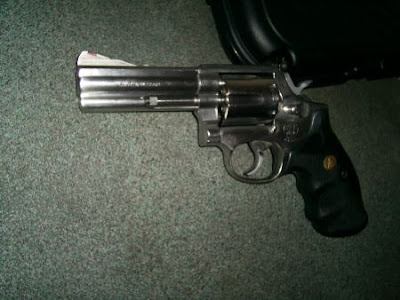Six basic rules for cleaning a firearm properly with Otis products.
Always clean from Breech-to-Muzzle® in the natural direction of the bullet.
- When you fire your gun, the powder residue and dirt are in the barrel. The chamber and receiver are clean. If you run a brush or patch from the muzzle end you will push this dirt, residue, and moisture into the chamber and receiver. This is a major cause of stuck cases or problems with lever actions and auto-loading rifles and shotguns. If you push or pull a brush back toward the chamber, you will notice the brush will throw the debris from the bore back into the chamber and locking lugs.
- When you fire your gun, the powder residue and dirt are in the barrel. The chamber and receiver are clean. If you run a brush or patch from the muzzle end you will push this dirt, residue, and moisture into the chamber and receiver. This is a major cause of stuck cases or problems with lever actions and auto-loading rifles and shotguns. If you push or pull a brush back toward the chamber, you will notice the brush will throw the debris from the bore back into the chamber and locking lugs.
Center the tip and rod. Be careful not to let either rub the bore.
- All firearms record their history. This is the reason most people look down the barrel of a firearm. An experienced eye can tell the method of cleaning, the number of shots, and the gun maintenance applied to the firearm. Many marks are caused by people who carelessly let the tip or rod rub the inside the barrel.
- All firearms record their history. This is the reason most people look down the barrel of a firearm. An experienced eye can tell the method of cleaning, the number of shots, and the gun maintenance applied to the firearm. Many marks are caused by people who carelessly let the tip or rod rub the inside the barrel.
Use a clean patch surface each time you go down the barrel.
- This is similar to mopping a floor and rinsing the mop out. When you are using your firearm you will get abrasive dirt in the muzzle. The patch with solvent will flush this dirt out in the shortest distance. If you use this patch surface again, the dirt will be deposited in the chamber and neck. The next bullet down the barrel picks up this dirt and erodes the throat. This is the exact equivalent of cleaning in the wrong direction.
- This is similar to mopping a floor and rinsing the mop out. When you are using your firearm you will get abrasive dirt in the muzzle. The patch with solvent will flush this dirt out in the shortest distance. If you use this patch surface again, the dirt will be deposited in the chamber and neck. The next bullet down the barrel picks up this dirt and erodes the throat. This is the exact equivalent of cleaning in the wrong direction.
Never run a brush in the barrel first.
- This will damage the firearm. The brush will pick up dirt, moisture or powder residue and deposit it into the chamber or receiver. Never dip a brush in solvent. The solvent at the brush core will collect dirt and drop it into the receiver and chamber.
- This will damage the firearm. The brush will pick up dirt, moisture or powder residue and deposit it into the chamber or receiver. Never dip a brush in solvent. The solvent at the brush core will collect dirt and drop it into the receiver and chamber.
Never go back and forth reversing the brush.
- This will bend the bristles on the brush. This is the equivalent of bending a wire back and forth until it breaks. You will always ruin a brush if you reverse it while in the bore.
- This will bend the bristles on the brush. This is the equivalent of bending a wire back and forth until it breaks. You will always ruin a brush if you reverse it while in the bore.
Use only a few drops of solvent / lubricant.
- Many people think the more solvent the better. However, this will damage the firearm. Use only the solvent that the patch will absorb. If you see too much, the solvent or oil will drip down into the trigger mechanism. This will cause a gummy trigger. If you use too much oil, it will drain back toward the stock and cause premature failure of the wood.























































